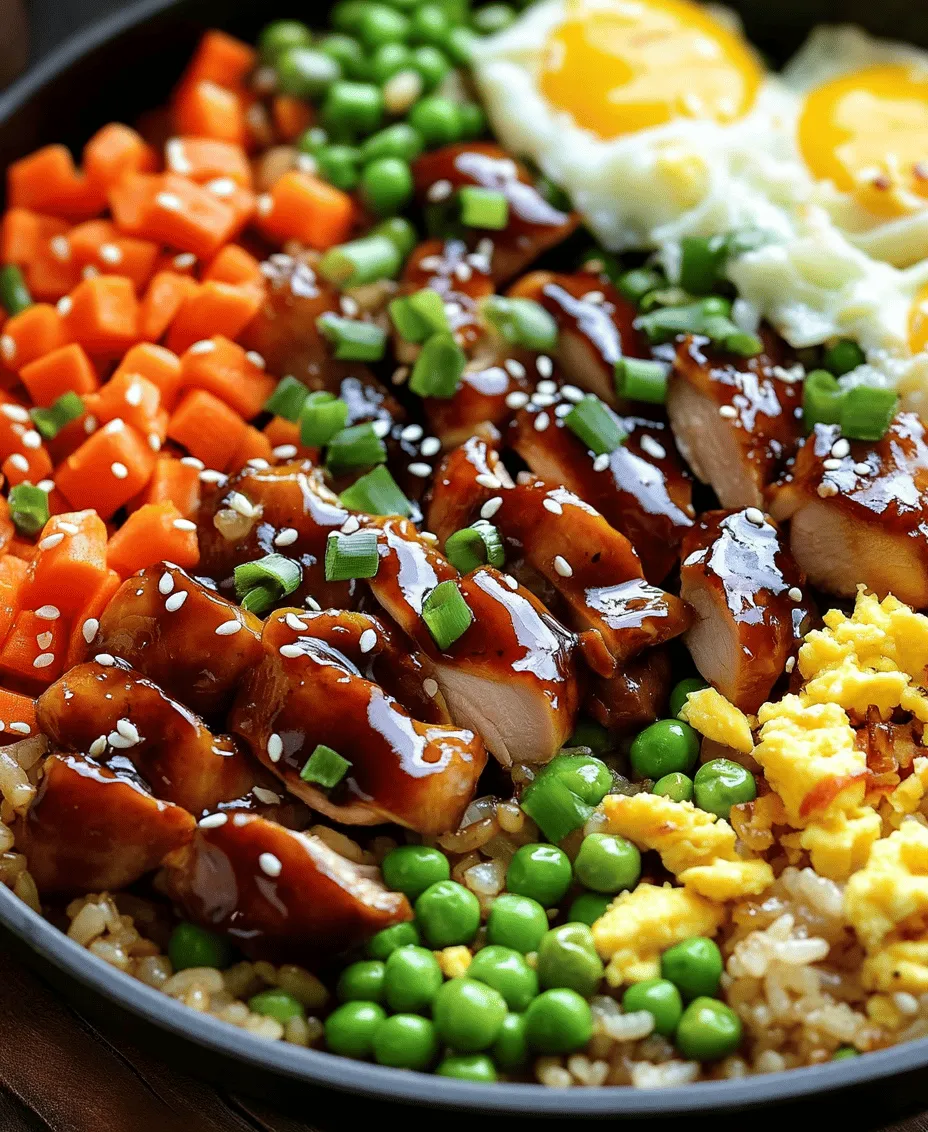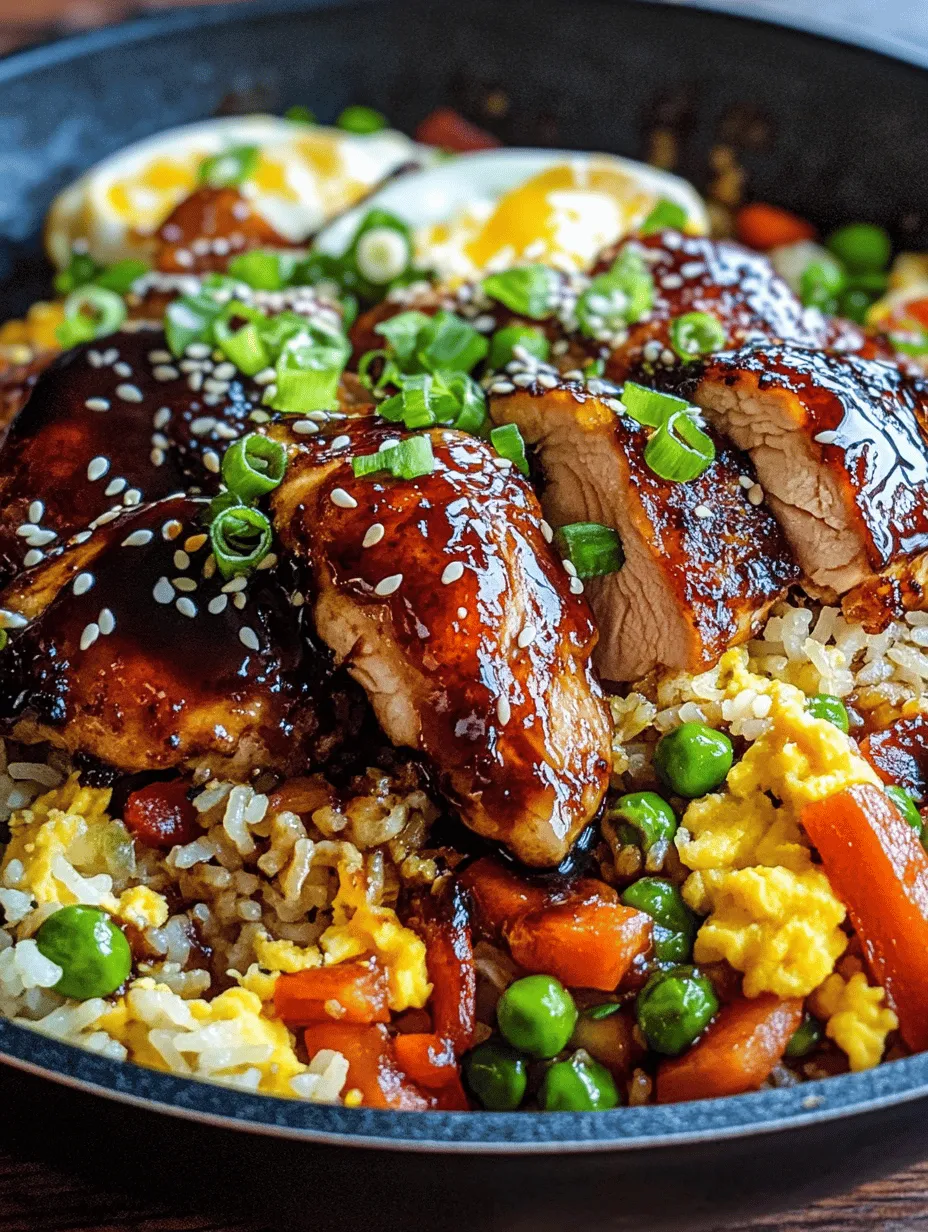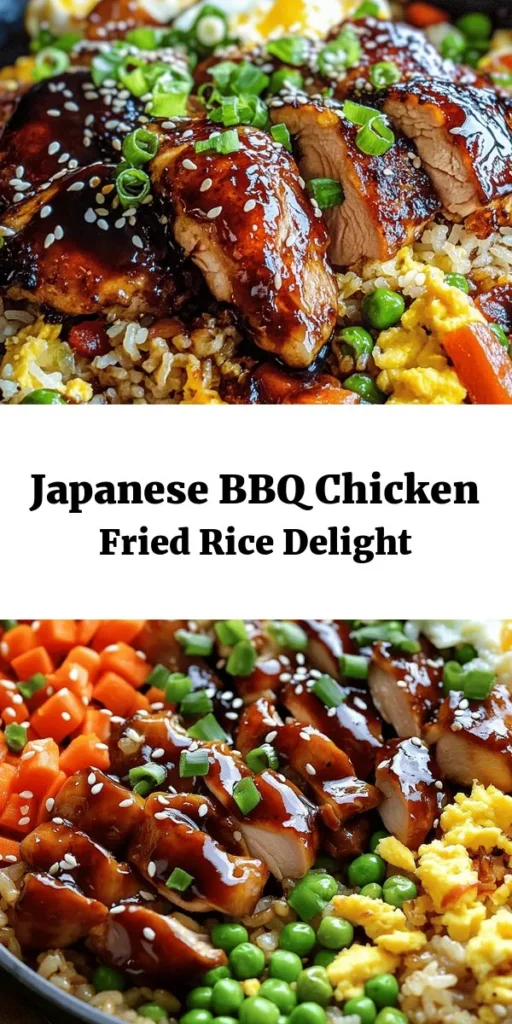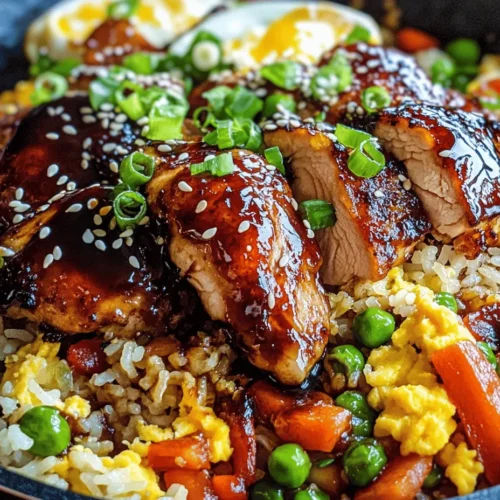Introduction
Welcome to the world of culinary fusion, where traditional flavors meet modern cooking techniques to create something truly extraordinary. Today, we’re diving into the savory depths of Savory Japanese BBQ Chicken Fried Rice Extravaganza. This dish is a delightful blend of rich, smoky Japanese BBQ flavors combined with the comforting, satisfying elements of fried rice, making it a perfect meal for any occasion.
Fried rice has long been a staple in many cultures, beloved for its versatility and ease of preparation. Whether you’re looking for a quick lunch, a hearty dinner, or a way to use up leftover ingredients, fried rice is an ideal choice. The beauty of this dish lies in its adaptability—while this recipe centers around Japanese BBQ chicken, you can easily customize it by adding your favorite vegetables, proteins, or even swapping out the rice for quinoa or cauliflower rice for a healthier twist.
Japanese cuisine has gained immense popularity globally, with more people embracing its unique flavors and cooking techniques. The rise of izakaya-style dining and street food culture has introduced many to the joys of dishes like yakitori and ramen. In this recipe, we celebrate the best of Japanese BBQ through the lens of a classic comfort food, bringing together the familiar and the exotic in a single bowl.
Understanding the Ingredients
To create this savory dish, we must begin with the key ingredients that not only contribute to the flavor but also enhance the nutritional profile of the meal. Here’s a closer look at each component that makes this Japanese BBQ Chicken Fried Rice truly special.
Jasmine Rice
First and foremost, we have jasmine rice, the foundation of our fried rice. While you can technically use any type of rice, jasmine rice is preferred for its fragrant aroma and slightly sticky texture, which helps the grains clump together just enough to create a satisfying bite. For the best results, it’s crucial to use day-old rice. Freshly cooked rice tends to be too moist and can lead to a mushy fried rice dish. By allowing the rice to cool and dry out in the refrigerator overnight, the grains firm up, making them perfect for stir-frying.
Chicken Thighs
Next up are the chicken thighs. While many recipes call for chicken breasts, we advocate for using boneless, skinless chicken thighs in this dish. Why? Because thighs are inherently juicier and more flavorful than breasts, thanks to their higher fat content. This added richness contributes to the overall flavor of the fried rice, ensuring each bite is succulent and satisfying. When marinated properly, chicken thighs absorb the flavors of the BBQ sauce beautifully, leading to a dish that’s bursting with taste.
Japanese BBQ Sauce (Yakitori Sauce)
No Japanese BBQ dish would be complete without a proper sauce. Enter yakitori sauce, a sweet and savory glaze that elevates the chicken and ties the entire dish together. This sauce typically consists of soy sauce, mirin (a sweet rice wine), sake, and sugar, creating a harmonious balance of umami and sweetness. As the chicken cooks, the sauce caramelizes, adding a deliciously sticky coating that enhances both the flavor and presentation of the dish. You can either purchase pre-made yakitori sauce or whip up a quick homemade version for a fresh, personal touch.
Vegetables
To add vibrancy and nutrition, we’ll incorporate a mix of colorful vegetables into our fried rice. Options such as bell peppers, carrots, peas, and green onions not only provide essential vitamins and minerals but also contribute texture and visual appeal. The addition of vegetables makes this dish well-rounded, ensuring that it’s not just delicious but also nutritious. You can easily tailor the vegetable mix to your preferences or seasonal availability, making this recipe endlessly adaptable.
Eggs and Aromatics
Finally, we have eggs and aromatics like garlic and onion. Eggs are a classic component of fried rice, adding richness and a silky texture that brings everything together. They also serve as a source of protein, enhancing the meal’s nutritional value. As for aromatics, sautéing garlic and onion at the beginning of the cooking process creates a fragrant base that builds layers of flavor. The combination of these ingredients will infuse your fried rice with a depth that is both comforting and complex.
Preparation Process
Importance of Preparing Ingredients Ahead of Time
Before diving into the cooking process, it’s essential to prepare all your ingredients ahead of time. This practice, often referred to as “mise en place,” helps streamline the cooking process and prevents chaos in the kitchen. When every ingredient is prepped and within reach, you can focus on cooking rather than scrambling to chop vegetables or measure sauces.
To set yourself up for success, begin by gathering all your ingredients, washing and chopping the vegetables, and marinating the chicken. By taking these steps, you’ll ensure a smooth cooking experience and help maintain the integrity of the dish.
Step-by-Step Guide to Marinating the Chicken
Marinating the chicken is a crucial step in achieving maximum flavor absorption. Here’s a detailed guide on how to do it effectively:
1. Cut the Chicken: Start with boneless, skinless chicken thighs. Cut them into bite-sized pieces to ensure even cooking and better flavor coverage.
2. Prepare the Marinade: In a mixing bowl, combine your yakitori sauce with additional ingredients like minced garlic, grated ginger, and a sprinkle of sesame oil for an extra layer of flavor.
3. Marinate: Add the chicken pieces to the marinade, ensuring they are well-coated. Cover the bowl with plastic wrap or transfer the mixture to a zip-top bag, squeezing out any excess air. Marinate in the refrigerator for at least 30 minutes, but for optimal results, aim for 2 to 4 hours. This allows the flavors to penetrate the meat fully.
4. Timing: If you’re short on time, even a quick 30-minute marinade will enhance the chicken’s flavor. However, for the best results, plan ahead and let the chicken marinate longer.
Cooking Methodology
Now that we have our ingredients prepped and our chicken marinated, it’s time to move on to the cooking process. Each step is designed to build layers of flavor and create a dish that is not only delicious but also visually appealing.
Cooking the Chicken: Techniques for Perfectly Cooked Chicken
When it comes to cooking the chicken, achieving a nice sear is crucial. Here’s how to do it:
1. Heat Your Pan: Start by heating a large skillet or wok over high heat. A hot pan is essential for getting that perfect sear on the chicken.
2. Add Oil: Once the pan is hot, add a tablespoon of oil (such as vegetable or canola oil) to the pan. Swirl it around to coat the surface evenly.
3. Sear the Chicken: Remove the chicken from the marinade (discard any leftover marinade) and add it to the hot pan in a single layer. Avoid overcrowding the pan, as this can cause the chicken to steam rather than sear. Cook for about 4-5 minutes without moving the chicken until golden brown. Flip the pieces and cook for another 3-4 minutes until fully cooked through.
4. Check for Doneness: The internal temperature of the chicken should reach at least 165°F (74°C). Once cooked, remove the chicken from the pan and set it aside while you prepare the rest of the dish.
Sautéing Aromatics: Creating a Flavor Base
With the chicken cooked to perfection, it’s time to build the flavor base by sautéing aromatics:
1. Reduce Heat: Lower the heat to medium and add a bit more oil to the pan if necessary.
2. Cook the Onions: Add diced onions to the pan first and sauté for about 2-3 minutes until they become translucent and fragrant.
3. Add Garlic: Next, add minced garlic to the pan and sauté for an additional 30 seconds until fragrant. Be careful not to burn the garlic, as it can turn bitter.
4. Building Layers of Flavor: At this point, the combination of sautéed onions and garlic creates a deliciously aromatic base that will infuse the fried rice with depth and complexity.
Stir-Frying Vegetables: Techniques for Maintaining Crispness
The final step in our cooking methodology is adding the vegetables and rice. To ensure that the vegetables remain crisp and vibrant, follow these tips:
1. High Heat is Key: Increase the heat back to high. This will help maintain the vegetables’ texture and color.
2. Add Vegetables: Add your prepped mix of colorful vegetables to the pan. Stir-fry them for about 2-3 minutes, just until they are tender but still crisp.
3. Incorporate the Rice: Once the vegetables are cooked, add the day-old jasmine rice to the pan. Break up any clumps with a spatula and stir-fry everything together for an additional 3-4 minutes.
4. Combine with Chicken: Finally, return the cooked chicken to the pan, along with any leftover juices. Mix everything well to ensure that the flavors meld together beautifully.
This marks the beginning of a savory and memorable experience that combines the essence of Japanese BBQ with the comforting nature of fried rice. As we progress through the remainder of this recipe, each step will bring us closer to a dish that not only satisfies the palate but also allows for creativity and personalization in the kitchen.




